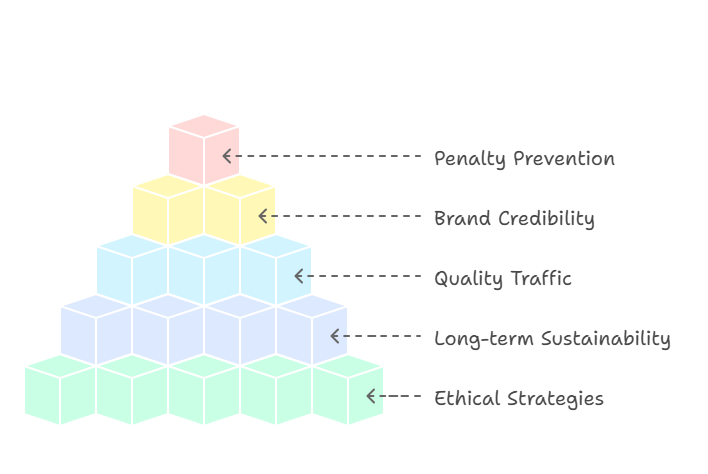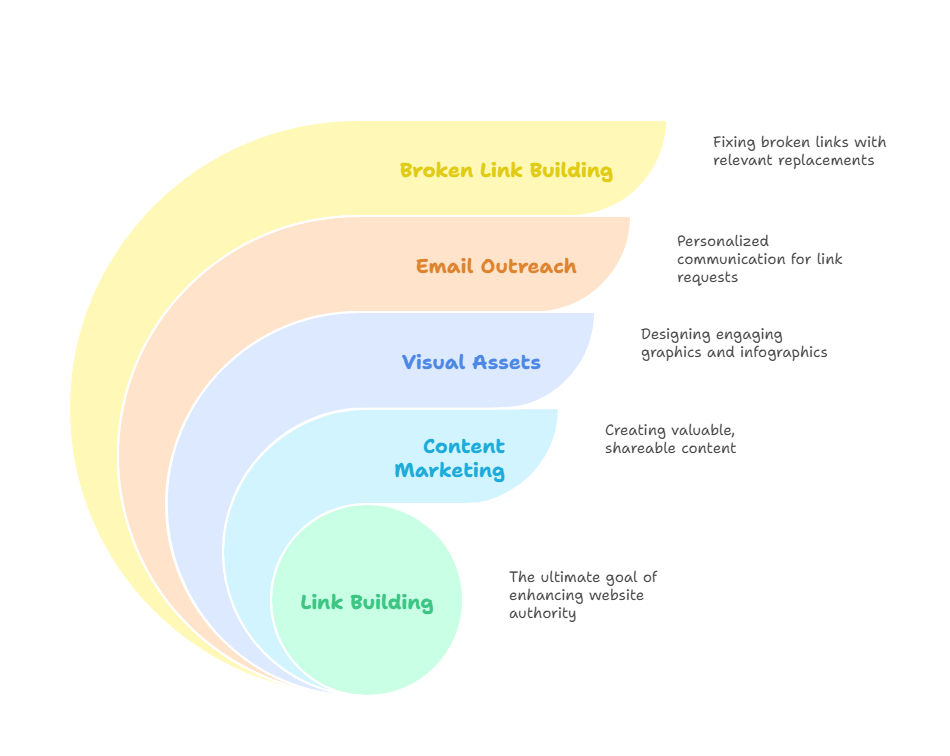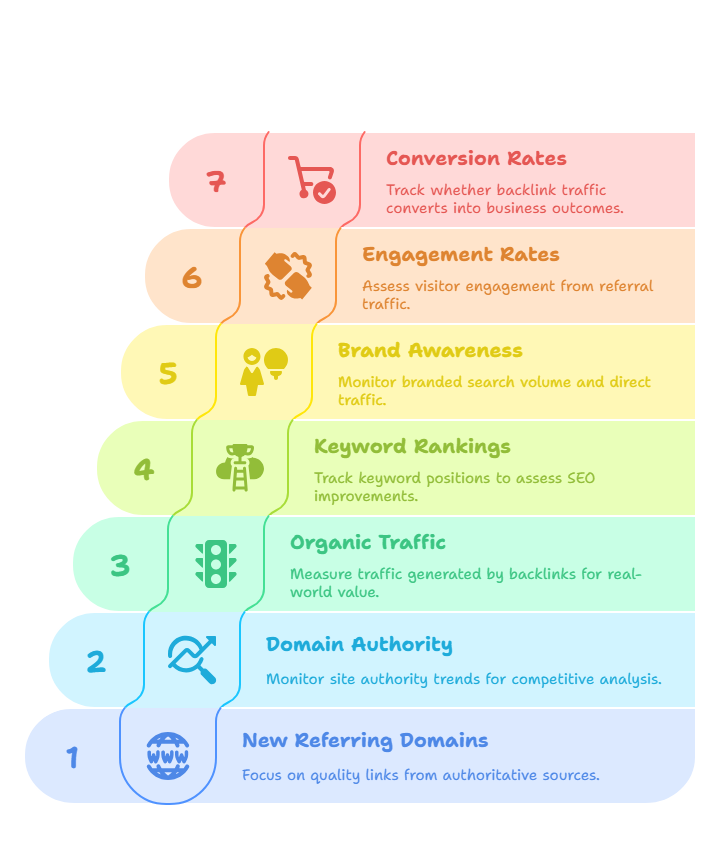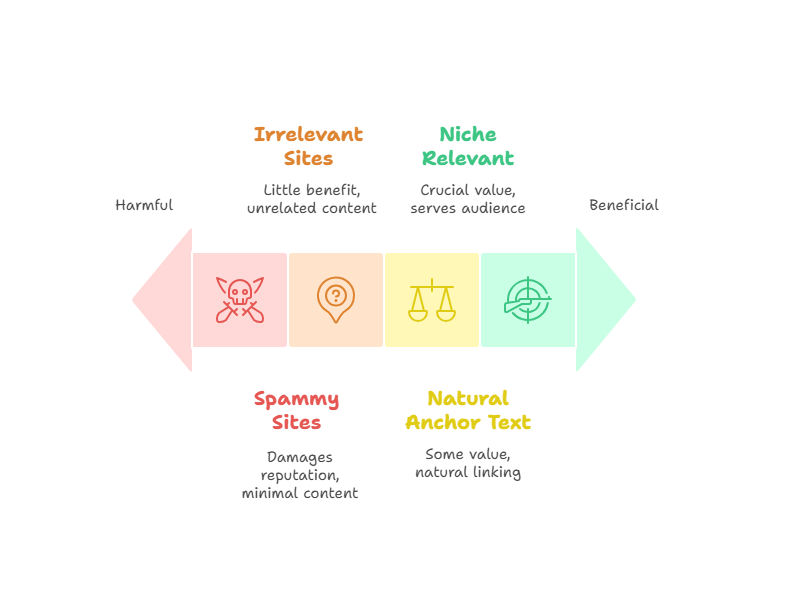Building backlinks is like creating meaningful relationships in the digital landscape. Quality connections matter more than quantity, and authentic partnerships outperform manipulative tactics every time. Just like genuine friendships, the most valuable backlinks develop naturally through trust, value, and mutual benefit.
If you’re seeking proven methods to build links ethically without risking Google penalties, this comprehensive guide provides everything you need.
We’ll explore cutting-edge white hat link building strategies for 2025, including AI-enhanced techniques that deliver measurable results while maintaining search engine compliance.
What Is White Hat Link Building?
White hat link building encompasses ethical, Google-approved strategies for acquiring backlinks that enhance rankings without violating search engine guidelines. This approach prioritizes long-term sustainability over short-term gains, focusing on genuine value creation rather than algorithmic manipulation.
According to recent data, websites using white hat link building strategies see 65% more sustainable traffic growth compared to those using manipulative tactics – a finding that underscores the importance of ethical approaches in modern SEO.

“The future of link building lies in creating genuine value and fostering authentic relationships. Shortcuts and manipulative tactics are becoming increasingly risky as search engines evolve,” – Brian Dean, Backlinko.
The fundamental principle involves creating content and resources so valuable that other websites naturally want to reference them. This could include original research, comprehensive guides, innovative tools, or simply building authentic relationships within your industry ecosystem.
Why It Matters
White hat link building delivers sustained authority improvements, increased referral traffic, and protection against algorithm penalties. Here’s why this approach should anchor your SEO strategy:
Long-term sustainability: Unlike risky tactics that may provide temporary benefits, white hat strategies build foundations that strengthen over time. Google’s algorithm updates consistently reward sites maintaining ethical practices, making this approach increasingly valuable.
Quality traffic generation: Visitors arriving through relevant, high-authority backlinks demonstrate genuine interest in your offerings. This translates to improved engagement metrics, reduced bounce rates, and higher conversion potential.
Brand credibility enhancement: Mentions and links from respected industry sources build your reputation and establish thought leadership. These endorsements carry weight beyond SEO benefits, influencing customer trust and business credibility.
Penalty prevention: Search engines have become sophisticated at detecting manipulative link schemes. White hat methods create protective barriers against algorithm updates and manual penalties that can devastate organic visibility.
Top White Hat Link Building Techniques That Actually Work
The following strategies represent proven methodologies that consistently deliver results when executed properly. Each technique has been tested across multiple industries and continues to perform effectively in the current search landscape.

Content Marketing
Content marketing remains the cornerstone of successful white hat link building. However, creating linkable content requires strategic planning and exceptional execution that goes beyond basic blog posts.
- Create high-value, shareable blog content: Develop comprehensive resources that address complex industry challenges. Instead of surface-level articles, create definitive guides that become go-to references. For example, a 5,000-word technical guide backed by original research will attract more links than ten 500-word posts on similar topics.
- Use stats, visuals, and up-to-date info to earn natural backlinks: Original data, current statistics, and professional visualizations make content infinitely more linkable. Publishers and bloggers actively seek credible sources to support their arguments, making data-rich content highly valuable.
A marketing agency recently created an extensive study analyzing email performance across 15 industries, surveying 12,000 businesses and presenting findings through interactive visualizations. This single resource generated 247 backlinks from industry publications, marketing blogs, and news outlets within six months.
The key involves thinking like a journalist or researcher. What information would strengthen your industry arguments? What data gaps exist in your field? Create those missing resources, and backlinks will follow naturally.
Infographics and Visual Assets
Visual content serves as link building gold because it simplifies complex information while enhancing content appeal. People share and embed visuals because they improve reader engagement and make their own content more compelling.
- Design original graphics or data visualizations: Focus on originality and unique perspectives. Combine different data sources, present familiar information innovatively, or visualize emerging industry trends. Professional design tools or skilled freelancers can help create publication-ready graphics.
- Offer easy embed codes and reach out to bloggers and publishers: Simplify the sharing process by providing ready-to-use embed codes that include proper attribution. Then proactively contact relevant websites that might benefit from your visual content.
Strategic timing significantly impacts visual content success. Creating infographics around trending topics, new regulations, or major industry events can maximize link potential. Being first to visualize breaking industry news often results in widespread sharing and linking.
A financial consulting firm created a comprehensive infographic explaining new small business tax regulations. Through targeted outreach to business blogs, accounting websites, and entrepreneur resources, this single visual asset earned 52 backlinks and generated thousands of social shares.
Email Outreach
Email outreach receives criticism because many practitioners execute it poorly. However, personalized, value-focused outreach remains one of the most effective link building methods when done correctly.
- Use personalized templates to pitch your content: Generic emails get deleted immediately. Effective outreach demonstrates genuine familiarity with the recipient’s website, audience, and recent content. Reference specific articles, acknowledge recent achievements, or mention unique aspects of their site.
- Focus on niche-relevant sites: A contextually relevant link from a smaller, specialized site often provides more value than a link from a large but unrelated website. Relevance remains a crucial ranking factor that Google evaluates carefully.
Here’s a proven email template structure that consistently generates positive responses:
Subject: Loved your insights on [specific topic]
Hi [Name],
Your recent article about [specific topic] really resonated with me, especially your point about [specific detail].
I recently published research on [related topic] that includes [specific valuable element]. Given your audience’s interest in [relevant area], I thought you might find it useful.
Happy to send it over if you’re interested. No worries if it’s not a fit.
Best regards,
[Your name]
This approach works because it leads with genuine value and demonstrates authentic engagement with their content rather than making immediate requests.
Broken Link Building
Broken link building represents a win-win strategy that helps website owners fix their sites while earning valuable backlinks. This technique works because you’re solving real problems rather than simply requesting favors.
- Find broken links on high-authority websites in your niche: Use tools like Ahrefs’ Broken Link Checker or browser extensions to identify broken outbound links on relevant websites. Focus on resource pages, industry guides, and link roundups in your sector.
- Suggest your active page as a replacement: Ensure your content genuinely matches the original broken link’s topic and quality. Don’t attempt to force irrelevant content into these opportunities.
The process involves identifying high-authority sites with broken outbound links, researching the original link content using the Wayback Machine, and reaching out with helpful notifications that include relevant replacement suggestions.
This technique succeeds because you’re providing immediate value by alerting website owners to problems while offering practical solutions. Most site owners appreciate broken link notifications and respond positively to helpful suggestions.
Guest Posting (The Right Way)
Quality guest posting remains highly effective despite past abuse by low-quality practitioners. When executed ethically, guest posting builds authority, establishes thought leadership, and generates valuable backlinks.
- Contribute quality articles to relevant blogs: Create original, high-value content specifically tailored to each target publication’s audience. Study their most successful posts, understand reader preferences, and identify content gaps you can fill expertly.
- Aim for sites with real audiences and editorial guidelines: Target publications with active engagement, social media presence, and clear editorial standards. Avoid guest posting networks or sites that accept any submitted content.
“Great guest posts aren’t repurposed content—they’re your best work created specifically for that audience. This approach builds lasting relationships and drives real results,” – Neil Patel, NeilPatel.com.
Successful guest posting requires thorough research and genuine audience understanding. Before pitching, engage with the publication’s content, understand their editorial voice, and identify topics that would genuinely benefit their readers.
Unlinked Brand Mentions
Converting unlinked mentions represents one of the simplest link building techniques because the foundation already exists. Someone has already deemed your brand worth mentioning—requesting a clickable link is typically a reasonable ask.
- Use tools to find where your name is mentioned without a link: Set up Google Alerts, use monitoring tools like Mention, or check Ahrefs’ “Brand mentions” report. Many businesses discover numerous unlinked mentions they weren’t aware of.
- Politely request the site to add a backlink: Most website owners comply with these requests because adding a link requires minimal effort while improving content utility for readers.
Here’s an effective template for unlinked mention requests:
Hi [Name],
Thank you for mentioning [Your Company] in your article about [topic]. We appreciate the kind reference!
Would you mind adding a link to our website when you mention us? It would help readers learn more about our services.
Our website is [your URL].
Thanks again for the mention!
Best,
[Your name]
This approach succeeds because it’s courteous, simple, and benefits both parties by making content more useful for readers.
Data-Driven Link Building
Original research and data function as powerful link magnets because journalists, bloggers, and content creators constantly seek credible statistics to support their arguments and add authority to their content.
- Publish original surveys or studies: Conduct industry research using tools like SurveyMonkey or Google Forms. Even modest sample sizes can yield valuable insights when questions are well-crafted and analysis is thorough.
- Promote your findings to journalists and bloggers: Actively distribute research findings to industry publications, relevant journalists, and influential bloggers who cover related topics.
Successful data-driven link building requires asking compelling questions that reveal surprising insights or challenge common industry assumptions. What trends is everyone discussing but nobody has quantified? What practices do people claim to follow but actually ignore?
Recent data shows that original research content generates 3.5x more backlinks than other content types, making this strategy particularly valuable for link building campaigns.
A software company surveyed 800 remote workers about productivity tool usage, discovering significant gaps between stated preferences and actual behavior. Major publications including Harvard Business Review and Forbes referenced this research, generating 73 high-authority backlinks and substantial brand exposure.
New Strategies for 2025: AI & Automation Tools
Artificial intelligence has transformed link building efficiency without replacing the fundamental need for relationship building and value creation. Smart implementation of AI tools can significantly enhance your outreach effectiveness and prospect identification.
Using AI for Prospecting
AI tools revolutionize link opportunity identification and initial outreach preparation, but they should enhance human judgment rather than replace strategic thinking.
- Tools like ChatGPT can help create outreach emails and analyze opportunities: Use AI to generate personalized email templates, research prospect backgrounds, and evaluate website quality. ChatGPT excels at helping scale personalization while maintaining authentic communication tone.
- Use SurferSEO or Respona to find link prospects based on content needs: These platforms leverage AI to identify websites likely to be interested in your content based on their linking history and topical focus.
Effective AI implementation involves feeding detailed prospect information into tools and using generated content as starting points for human customization. The technology handles research and structure while humans add personal touches and strategic insights.
However, never send AI-generated emails without substantial editing. While AI provides excellent frameworks and ideas, final messages must feel genuinely personal and demonstrate authentic understanding of the recipient’s needs.
Workflow Automation
Administrative tasks in link building can be time-consuming, making automation particularly valuable for handling logistics while preserving human elements in relationship building.
- Automate follow-up emails and tracking with tools like Pitchbox or BuzzStream: These platforms manage outreach pipelines, schedule follow-up sequences, and track response rates. Automation handles timing and organization, freeing humans to focus on relationship development.
- Still ensure each message feels personal: Use automation for scheduling and tracking, but maintain human oversight for all communications. Automated workflows should support, not replace, genuine relationship building efforts.
The most effective automation systems handle repetitive tasks like database management, response tracking, and follow-up scheduling while ensuring every outbound message receives human review and customization.
“AI should amplify human creativity in link building, not replace it. The best campaigns combine technological efficiency with authentic relationship building,” – Rand Fishkin, SparkToro.
How to Measure Link Building Success
Effective measurement requires tracking metrics that align with business objectives rather than vanity numbers that look impressive but don’t drive results. Focus on indicators that demonstrate real progress toward your goals.

Track These Key Metrics
Monitor metrics that provide actionable insights and demonstrate genuine campaign impact on your overall SEO performance and business objectives.
- New referring domains: Track unique websites linking to your content. Quality supersedes quantity—ten links from relevant, authoritative sources provide more value than 100 links from random, low-quality sites.
- Domain Rating (Ahrefs) or Domain Authority (Moz): Monitor overall site authority trends while recognizing these metrics as general indicators rather than definitive measures. Use them for competitive analysis and long-term progress tracking.
- Organic traffic from linked pages: Measure actual traffic generated by backlinks using Google Analytics referral reports. This metric demonstrates real-world value beyond theoretical SEO benefits.
- Keyword rankings before and after campaigns: Track target keyword positions throughout link building campaigns, understanding that SEO improvements require time and consistent effort.
Additionally, monitor secondary metrics that reveal broader campaign impact:
Brand awareness indicators: Track branded search volume increases and direct traffic growth. These metrics often indicate successful link building campaigns even when direct attribution is difficult.
Engagement from referral traffic: Visitors from relevant backlinks typically demonstrate higher engagement rates, longer session durations, and stronger conversion potential.
Conversion rates from referral sources: Ultimate success depends on business impact. Track whether backlink traffic converts into leads, customers, or subscribers at rates that justify your investment.
How to Vet Backlink Quality (And Avoid Toxic Links)
Link quality evaluation prevents wasted effort and protects against potential penalties. Not all linking opportunities provide value, and some can actively harm your search performance.

Checklist for a Healthy Backlink
Evaluate every potential link opportunity against these criteria before investing time and effort. Quality links should meet most of these standards to justify pursuit.
- Comes from a niche-relevant site: Relevance remains crucial for link value. A link from a cooking blog won’t help an accounting firm’s rankings. Target sites that serve your audience or operate within your industry ecosystem.
- Has organic search traffic: Sites that don’t rank for relevant keywords can’t transfer meaningful authority. Verify that potential link sources receive organic traffic using tools like Ahrefs or SEMrush.
- Doesn’t have spammy outbound links: Review the site’s other content and linking patterns. Avoid sites that participate in obvious link schemes, sell links openly, or link to questionable destinations.
- Uses natural anchor text: Link text should read naturally and avoid over-optimization. Vary anchor text across links using branded terms, URLs, and natural phrases rather than exact-match keywords exclusively.
Additional warning signs to avoid:
Sites with minimal original content: Websites that exist primarily to sell links or host thin, auto-generated content provide no value and may damage your reputation.
Irrelevant foreign language sites: Unless targeting specific international markets, links from unrelated foreign language sites typically provide little benefit.
Obviously manipulative SEO tactics: Sites with excessive outbound links on every page, keyword-stuffed content, or other obvious manipulation attempts should be avoided entirely.
Tools to Use
These essential tools help evaluate link opportunities and monitor your existing backlink profile for potential issues:
- Ahrefs Site Explorer: The industry standard for backlink analysis, providing Domain Rating scores, organic traffic estimates, and comprehensive backlink profiles. Use the “Top Pages” report to identify a site’s best-performing content.
- SEMrush Backlink Audit: Excellent for identifying potentially harmful links in your existing profile. The tool automatically flags suspicious patterns and helps create disavow files when necessary.
- Google Search Console manual actions: Monitor this section regularly to catch any Google-identified link issues early. Manual actions for unnatural links require immediate attention and cleanup efforts.
Regular backlink monitoring helps identify negative SEO attacks or low-quality links before they impact your rankings. Most isolated bad links won’t cause problems, but maintaining overall profile health remains important.
FAQs About White Hat Link Building
These frequently asked questions address common concerns and misconceptions about ethical link building practices.
How many backlinks do I need?
Link requirements depend entirely on competitive landscape analysis rather than arbitrary numbers. Focus on consistent quality over quantity targets. Some sites achieve first-page rankings with 50 high-quality backlinks, while others need 500+ links in highly competitive industries.
Analyze top-ranking competitors for your target keywords to understand benchmark requirements. However, avoid obsessing over specific numbers. Consistent acquisition of 2-3 quality links monthly often outperforms sporadic bursts of 20 low-quality links.
Is it safe to buy links?
Purchasing links violates Google’s quality guidelines and carries significant penalty risks. Modern search engines excel at detecting paid link schemes, and consequences can be devastating to organic visibility.
Businesses have lost 80% or more of organic traffic overnight due to paid link penalties. Short-term ranking gains never justify long-term risks. When approached with link selling offers, especially those promising “high DA links” at low prices, decline immediately.
How long does it take to see results?
Ranking improvements typically appear within 2-6 months depending on industry competitiveness and campaign consistency. SEO requires patience, and link building follows similar timelines.
Realistic expectations based on industry experience:
Months 1-2: Links begin appearing in analysis tools with minimal ranking impact.
Months 3-4: Small improvements for less competitive keywords become visible, with referral traffic starting to increase.
Months 5-6: More significant ranking improvements emerge, especially with consistent effort.
Month 6+: Compounding effects accelerate as improved authority facilitates additional link acquisition and competitive keyword rankings.
Individual results vary significantly based on starting authority, competitive landscape, and campaign execution quality.
Final Thoughts
White hat link building requires patience and persistence, but it’s the most reliable path to sustainable search engine authority. Implement the proven strategies outlined above, maintain consistent measurement practices, and prioritize authentic relationship building over manipulative tactics.
Digital marketing evolves constantly, but ethical link building principles remain stable: create genuine value, build meaningful relationships, and focus on audience needs. These fundamentals have guided successful SEO for decades and will continue working regardless of algorithm changes.
Begin with one or two strategies rather than attempting everything simultaneously. Master content marketing and email outreach first, then expand into additional techniques as your confidence and skills develop.
The most successful link builders prioritize helping others over personal gain. When you consistently provide value to your industry, backlinks become natural byproducts of the relationships you build and the resources you create.


